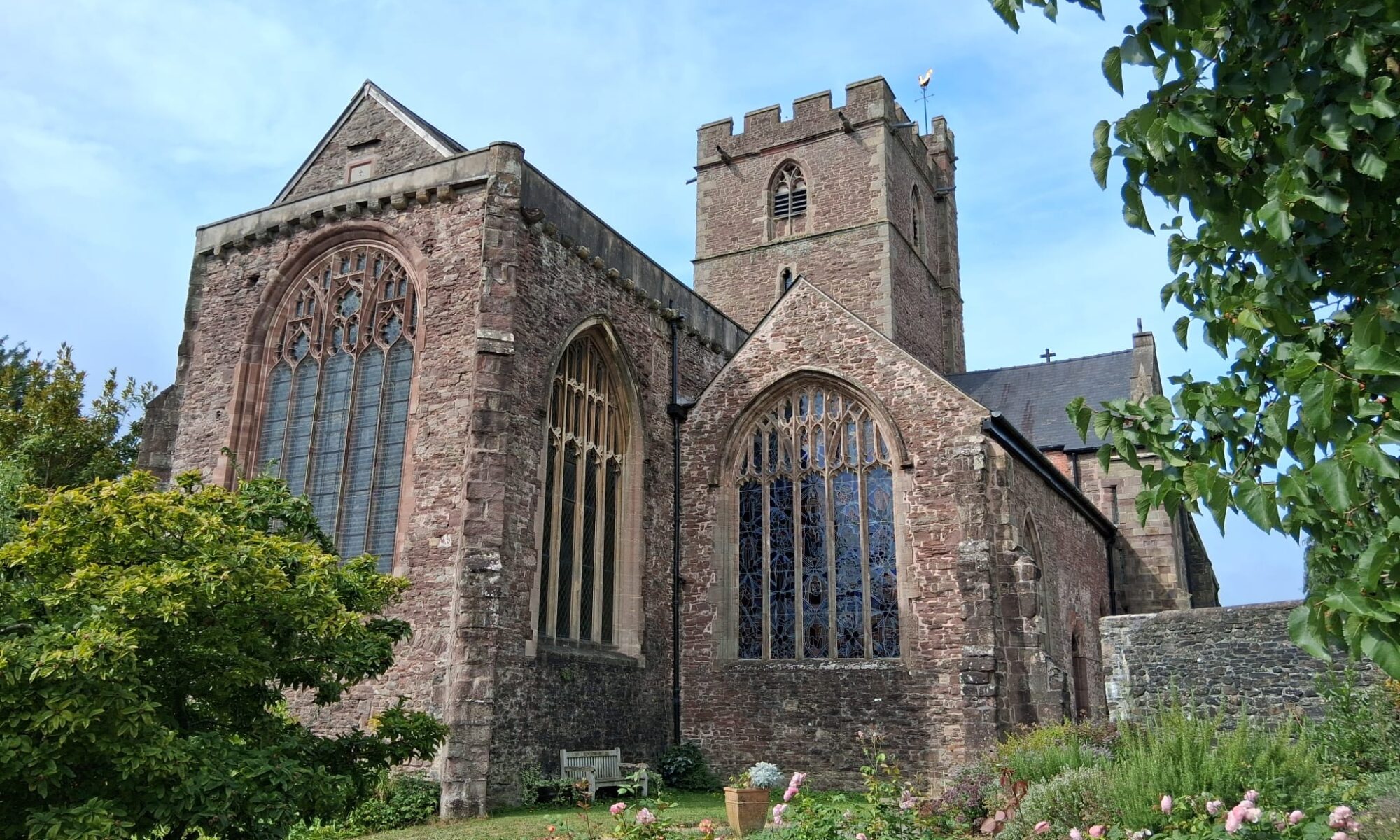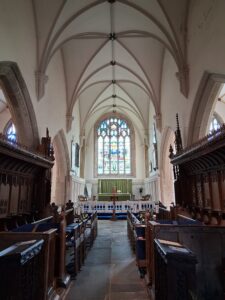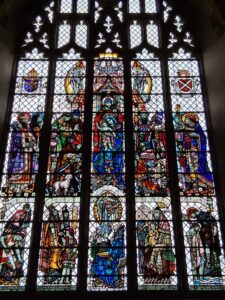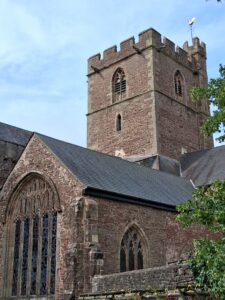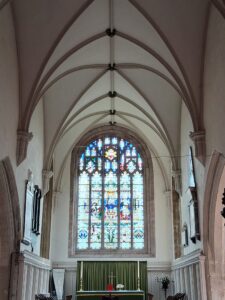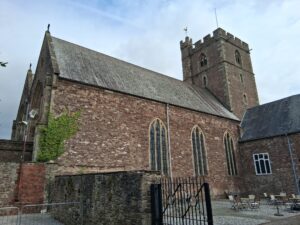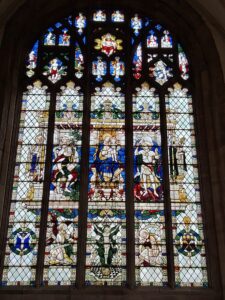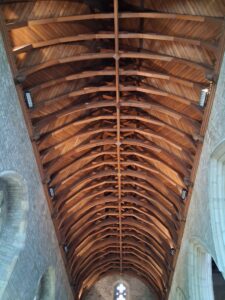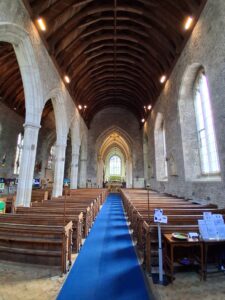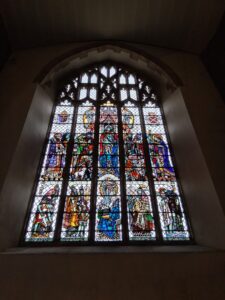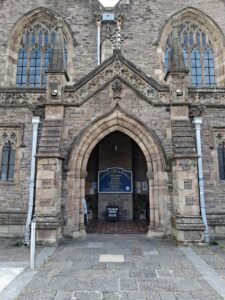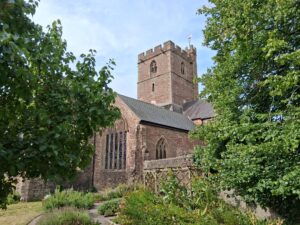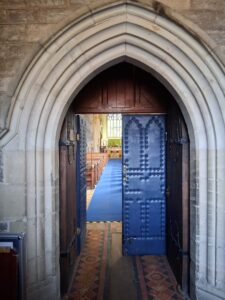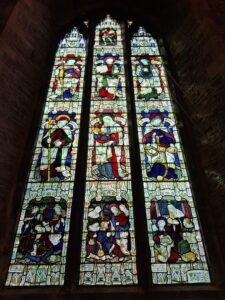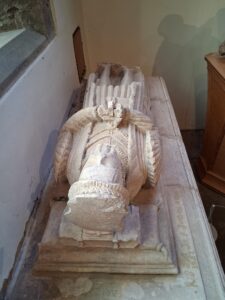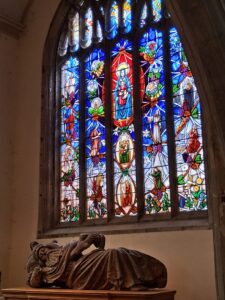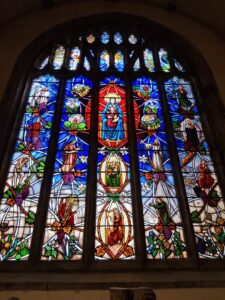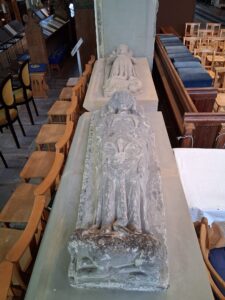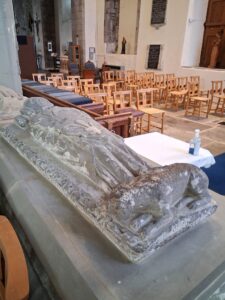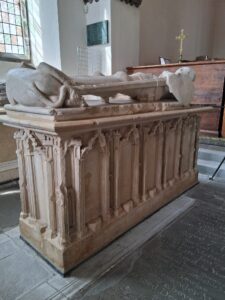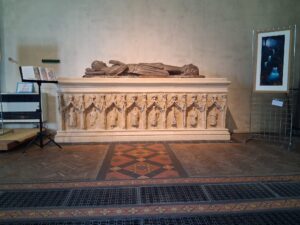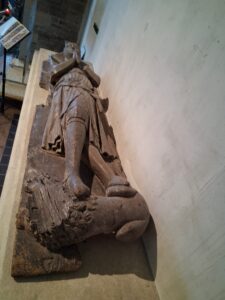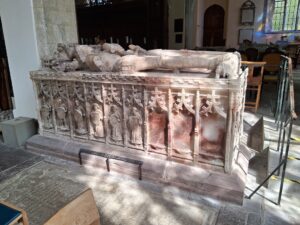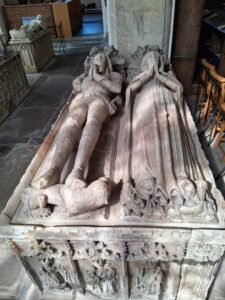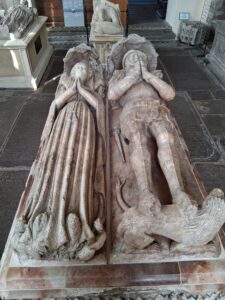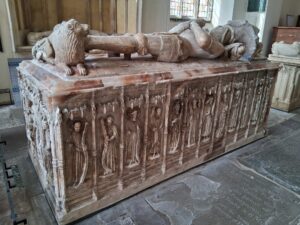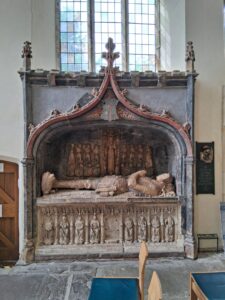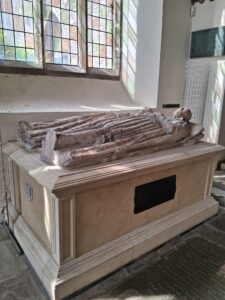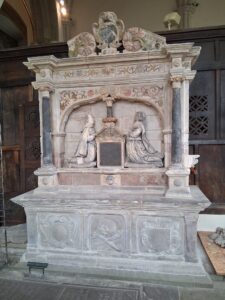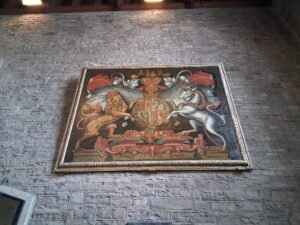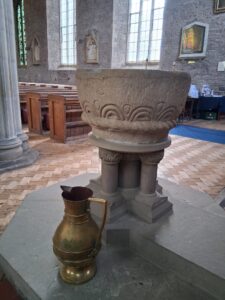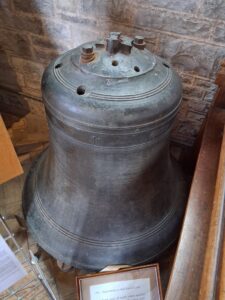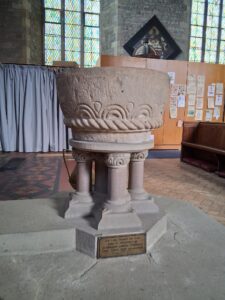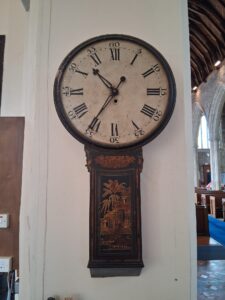St Mary’s Priory is a historic church at the eastern end of the market town of Abergavenny. The church is known as ‘the Westminster Abbey of Wales’. The church is home to many treasures which include a collection of beautiful tombs and monuments, a medieval font, and several impressive stained-glass windows. But its greatest treasure is an incredible 15th century carving of Jesse, father of king David in the Bible, as the base of a much larger work known as the Jesse tree.
This guide provides details on what to see, the layout and architecture of St Mary’s Priory church, its history, links with Abergavenny Castle and a look at some of the names of those buried in the church.
St Mary’s Priory Layout
St Mary’s Priory is mainly a Victorian refurbishment. Sadly, very little, if any, of the Norman church remains. St Mary’s Priory is a traditional cruciform layout plan, although this is hard to see when first walking in. Entrance is made into the centre of nave.
The nave is impressively large but confuses me slightly. To the northern side there is clear evidence of the bays that are normally seen in churches and cathedrals. The northern aisle is similar in shape and design to that of nave. To the south is a fixed wall, external looking, with windows offering much light into the church. It appears that maybe the southern aisle was forgotten in the rebuilding process. The contrast of north and south sides of the nave is stark.
At the crossing is a nave altar with a central tower above. The transepts to the north and south are clearly visible and lead to separate chapels – Lewis chapel to the north and Herbert chapel to the south. In the northern transept is a Wooden effigy of Sir John de Hastings II.
The choir is sandwiched between these two chapels (Lewis and Herbert) with the sanctuary being at the far eastern end of the church. In the choir are finally carved monastic stalls from the 15th century.
The Lewis chapel is named after Dr David Lewis who was the first principal of Jesus College, Oxford. Dr David became a judge of the High court of the Admiralty in the reign of Elizabeth 1st. The Herbert Chapel is named after a couple of gentlemen who are buried there.
History of St Mary’s Priory
St Mary’s Priory founding
A Benedictine Priory and church of St. Mary was founded towards the end of the 11th century by the first Anglo-Norman Lord of Abergavenny Hamelin de Ballon. Hamelin was granted the Lordship of Abergavenny by William II and was the man who built Abergavenny Castle.
St Mary’s Priory was attached as a ‘cell’ to the Abbey of St Vincent near Le Mans in Normandy. This is like the recently visited St George’s Priory Church in Dunster, which was a cell of Bath Abbey. I presume the link with Le Mans is due to Hamelin being a Norman knight who was born in Ballon, near to Le Mans, in France.
A ‘Priory’
As my learning flourishes it is important I find out what a priory is. A priory is a religious community built to house monks or nuns. In Abergavenny’s case monks lived in a monastic order and followed the rule of Saint Benedict. A priory church was built within their community to allow prayer and worship. This would have been separated from towns people who would have had their own church. Priories could have been independent or a cell of an abbey.
Medieval St Mary’s Priory
St Mary’s Priory went through good and bad times. Being so far away from its master abbey I’m sure this led to some of these problems. Rumours, many substantiated, of ill-discipline, drinking, gambling and adultery by the monks and prior had left the priory neglected. When the then current Lord of Abergavenny (John de Hastings) discovered these misdemeanours, reformations were made, with notably more lands passing to the priory.
When Owain Glyndwr destroyed Abergavenny, so too was St Mary’s Priory. Rebuilding took place after the Pope gave a grant of indulgence for church repairs in 1428. The people of Abergavenny also raised money to help with the repairs. This led to the priory enjoying a period of great prosperity. A tithe barn was built to collect annual tithes from people working on the priory’s lands.
Dissolution of the Monasteries
When Henry VIII’s divorce from the Roman Catholic church took place, the effects were felt across the land. St Mary’s Priory being part of the Catholic order was no exception. By now, though the local community influence was great, they were already using the church (sharing with the remaining monks) as they had outgrown their church (St. Johns on the other side of town).
A settlement was made through the Lord of Abergavenny with Henry VIII that St Mary’s Priory church would become the town’s parish church. Then with some of the revenues from the priory a school would be established in their old parish church.
English Civil War
Not only did St Mary’s Priory survive the reformation, but it navigated its way through the Civil War as well. A visit to Abergavenny Castle showed how Abergavenny played a role in the Civil War as King Charles I tried to raise an army before Cromwell and his army garrisoned the castle. Cromwell and his troops vandalised much of the country, pursuing the Puritan way but somehow the ‘Jesse’ carving avoided Cromwell’s ravages.
St Mary’s Priory in the 19th century
During the Victorian period St Mary’s Priory changed severely as the nave and northern aisle were demolished and rebuilt. The Victorian refurbishment program, sadly, leaves little traces of the original Norman architecture. They did, however, find the Norman baptismal font in the churchyard.
Treasures of St Mary's Priory
Jesse
The greatest of the St Mary’s Priory treasures is now housed in the Lewis Chapel. Dating back to the 15th century is a unique representation of Jesse. This piece was carved from a solid piece of oak and makes it unique. It is part of a reredos (an altarpiece) that would have stood 20-30 feet high with carvings of the exalted Christ and the Virgin Mary at its apex. ‘Jesses’ were normally displayed in stone and stain glass. Behind its current location is the ‘Jesse Window’. Created by Helen Whittaker of Barley Studios in York, it encapsulates the various themes and messages from the bible.
Eva de Braose
The oldest monument in St Mary’s Priory Church belongs to Eva de Braose. She died in 1256 and was part of the infamous de Braose family that had such gruesome history with Abergavenny Castle. If you look closely at her monument the shield that she is holding is decorated in the Cantilupe (the family she married into) fleur-de-lis (lily flower). You will find her monument in the chancel area.
Sir Lawrence de Hastings (d.1348)
The Hastings dynasty rebuilt much of Abergavenny castle and the last member of the family to be buried here is Sir Lawrence de Hastings. Sir Lawrence fought at the battle of Crecy (1346) and Sluys (1340) in the 100 years’ war. Sir Lawrence’s son John married Margaret Plantagenet, daughter of King Edward I.
Sir John de Hastings II (d.1324)
Sir John’s wooden effigy is in the northern transept. John’s effigy has been beautifully carved and shows him praying with his feet on a lion. John was heavily involved in rebuilding of St Mary’s Priory in 14th century.
Sir Richard Herbert (d.1469) of Coldbrook & Margaret
Sir Richard was the owner of Coldbrook Estate, Llanover, Monmouthshire. A short drive south of Abergavenny, the estate remains but the house is no more. Sir Richard was the second son of William ap Thomas (William brought and greatly expanded Raglan Castle) who is also buried in St Mary’s Priory. Richard Herbert and his brother were heavily involved in the Wars of Roses and after losing the battle of Edgcote (24th July 1469) were beheaded. Edgcote is in West Northamptonshire, and the battle took place between the earls of Pembroke and Devon loyal to the crown and a rebel force led by the Earl of Warwick.
William ap Thomas and the Lady Gwladys
William fought in the battle of Agincourt (1415); his exploits led to his knighthood. This brought about much wealth and power. He purchased the norman Raglan Castle and along with his son William Herbert (William took the name Herbert when Edward IV gave him the title Baron Herbert) built the ‘grandest castle’ ever built by a Welshman.
Sir Richard Herbert of Ewyas
He was the illegitimate son of William Herbert 1st Earl of Pembroke (Richard was the grandson of William ap Thomas and nephew of Sir Richard Herbert both buried in St Mary’s Priory). His family tried to give him respectability by giving him the lordship of Ewyas. He married into the Cradock family. His eldest son would marry Anne Parr, sister of Katherine Parr (Henry VIII’s sixth wife).
St Mary's Priorys other monuments
In the Herbert Chapel there are two other tombs of note. Firstly, the tomb of William Baker (d.1648) and his wife, Joan. William was the nephew of David Augustine Baker.
Secondly, the tomb of Judge Andrew Powell (d.1631) and Margaret. Margaret was the daughter of Mathew Herbert of Coldbrook.
Located elsewhere around the church are the pre-Norman font, a bell dated from 1308, and the royal arms of Queen Anne dated 1709. The pre-Norman font is older than the original church itself. A very proud church warden informed me of this on my visit, and this has been confirmed in the guide he gave me. As mentioned previously this font was found buried in the courtyard. Where it was perhaps hidden during the Commonwealth period when the baptism of infants was unacceptable.
St Mary’s Priory Conclusions
St Mary’s Priory has been wonderfully pleasant visit – surprising in matter of fact. Assumptions are never good. Looking from the outside it wasn’t that impressive but after stepping inside I’ve been blown away with the history that is entombed inside.
It’s not called ‘Westminster Abbey of Wales’ without reason. It is not on the scale of Westminster Abbey or boasts the same number of famous tombs and monuments but in St Mary’s there are several important persons from yesteryear who are buried there.
It’s a shame that little of the medieval church survives but the links between the church and castle are fascinating. The famous people learnt about at Abergavenny Castle are buried in the church.
The church layout confused me somewhat with a lack of the south aisle throwing my understanding of the church plan out the window.
This meandering though has taught me something new about the royal coats of arms that are often displayed in churches. I never knew why they were there. Henry VIII instructed the royal coat of arms to be displayed in all churches after his reformation to show that the monarchy was now the head of the church. A lot of these were removed by Mary I. Many were replaced during the reigns of Elizabeth, James I, Charles I & II, William III and Mary II. Something to keep my eye out for when next stepping inside a church.
The two chapels at St Mary’s Priory provide me with further inspirational meanderings. After learning about William ap Thomas and the ‘Herbert’ family a visit to Raglan Castle seems a necessity. How easy it is to visit Dr David Lewis’s connections to Oxford University and Jesus College remains to be seen.

